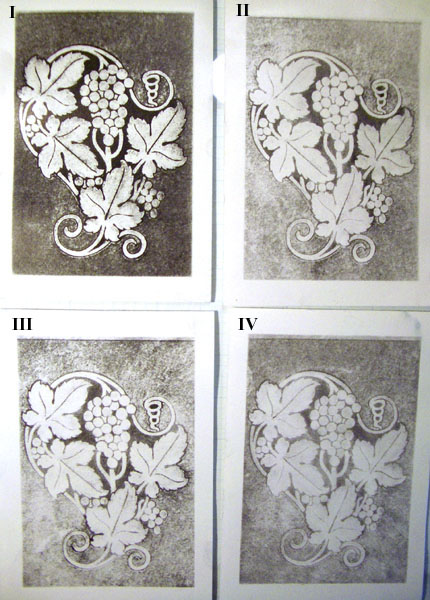 |
|||
|
|
|
Conclusions I inked each print as well as I could by hand using a soft brush. I’m sure I could let II, III, and IV dry, ink them more on another day, and almost certainly get a better result. But the first print, which did not receive any acid treatment, obviously produced a matrix that took ink more readily. We can say the acid softened the gelatine to the extent that it absorbed more water and therefore repelled ink, or we can say the acid reduced the “tooth” of the gelatine so it would not accept ink as well. There remain the questions, what would the result be if I were to use a greater dilution of EDTA or less bisulfite in the fix, or what would happen with different papers, but for the time being I am convinced that acidic baths do not add anything useful for my purposes. Your mileage may vary. I know there are bromoilists who still use the acid bath and get perfectly acceptable results. One in particular, RenÚ Smets, uses very soft ink, soaks his matrices at 40║C (104║F), and his prints are exceptional. Everything I have read tells me that the older silver-gelatine emulsions were much softer than modern emulsions, yet many early bromoilists speak of soaking matrices for at least an hour, usually in water at room temperature (which, in England, may have been relatively cold). Nonetheless, that is a long soak by my own standards--I typically use 5 to 10 minutes at room temperature. In addition, many early bromoilists were also using an acid bath which, as my experiment has shown, must have had a softening effect on the emulsion. I might conclude that early bromoilists were using much softer ink than some contemporary bromoilists use, and possibly that the early ferricyanide bleaches left emulsions harder than copper sulphate bleaches. A future experiment may be in order to learn more about the qualities of ferricyanide bleaches in regard to bromoil matrices. In my own work with the oil process, I needed to use much softer inks than I use for bromoil. It would make sense that early workers in bromoil would have carried over their own experience from oil to bromoil. The soft ink they were most probably accustomed to using may not have worked well on bromoil unless they softened the emulsion further--hence, the origin of the acid bath. The workers in oil talked about using hard and soft ink, but we have no way of knowing just how hard or soft their ink may have been when compared with our own. Finally, if you wish to get rid of chromium stain but don’t want to lose tooth on the matrix, the simplest solution is to use an acid bath after the print has been inked and dried. This works better than a bath before or after fixing the matrix. Longer times in the bath are not a problem after inking. Better yet, the difference in reflected light is measurable both by density readings and by visual inspection--the prints actually look brighter than they did before the bath. Even if you haven’t had a “problem” with chromium stain, there is a good chance that your bromoils will benefit from an acid after-bath. Further Reading: The Bromoil Reading Room
|
|
|
|
|
